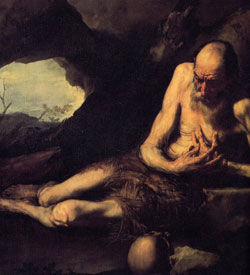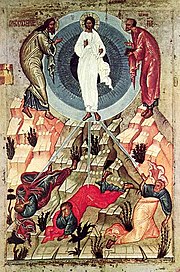
Feastday: January 15
Patron: of San Pablo City, Philippines
Birth: 229
Death: 342
Also known as Paul the First Hermit and Paul of Thebes, an Egyptian hermit and friend of St. Jerome. Born in Lower The baid, Egypt, he was left an orphan at about the age of fifteen and hid during the persecution of the Church under Emperor Traj anus Decius. At the age of twenty two he went to the desert to circumvent a planned effort by his brother in law to report him to authorities as a Christian and thereby gain control of his property. Paul soon found that the eremitical life was much to his personal taste, and so remained in a desert cave for the rest of his reportedly very long life. His contemplative existence was disturbed by St. Anthony, who visited the aged Paul. Anthony also buried Paul, supposedly wrapping him in a cloak that had been given to Anthony by St. Athanasius. According to legend, two lions assisted Anthony in digging the grave. While there is little doubt that Paul lived, the only source for details on his life are found in the Vita Pauli written by St. Jerome and preserved in both Latin and Greek versions.
| Part of a series on | |||||||||||||||||||||||||||||
| Christian mysticism | |||||||||||||||||||||||||||||
|---|---|---|---|---|---|---|---|---|---|---|---|---|---|---|---|---|---|---|---|---|---|---|---|---|---|---|---|---|---|
 | |||||||||||||||||||||||||||||
Theology · Philosophy
|
|||||||||||||||||||||||||||||
Practices
|
|||||||||||||||||||||||||||||
People (by era or century)
|
|||||||||||||||||||||||||||||
Literature · Media
|
|||||||||||||||||||||||||||||
|
Paul of Thebes, commonly known as Paul, the First Hermit or Paul the Anchorite (Egyptian Arabic: Anba Bola; Coptic: Ⲁⲃⲃⲁ Ⲡⲁⲩⲗⲉ; c. 226/27 – c. 341), is regarded as the first Christian hermit, who was claimed to have lived alone in the desert of Egypt from the age of sixteen to the age of one hundred and thirteen years old. He is not to be confused with Paul the Simple, who was a disciple of Anthony the Great. He is venerated as a saint by the Catholic Church as well as the Orthodox Church.
Legend
 Relics in Santa Maria in Porto, in Ravenna.
Relics in Santa Maria in Porto, in Ravenna.
The Life of Saint Paul the First Hermit (Vitae Patrum (Vita Pauli primi eremitae)) was composed in Latin by Saint Jerome, probably in 375–376. Paul of Thebes was born around 227 in the Thebaid of Egypt.
Paul and his married sister lost their parents. In order to obtain Paul's inheritance, his brother-in-law sought to betray him to the persecutors. According to Jerome's Vitae Patrum (Vita Pauli primi eremitae), Paul fled to the Theban desert as a young man during the persecution of Decius and Valerianus around AD 250.
He lived in the mountains of this desert in a cave near a clear spring and a palm tree, the leaves of which provided him with clothing and the fruit of which provided him with his only source of food until he was 43 years old, when a raven started bringing him half a loaf of bread daily. He would remain in that cave for the rest of his life, almost a hundred years.
 Paul of Thebes’ visit at Anthony the Great
Paul of Thebes’ visit at Anthony the Great
 Saint Anthony the Great and Saint Paul the Anchorite, Diego Velázquez, circa 1634
Saint Anthony the Great and Saint Paul the Anchorite, Diego Velázquez, circa 1634
Paul of Thebes is known to posterity because around the year 342, Anthony the Great was told in a dream about the older hermit's existence, and went to find him. Jerome related that Anthony the Great and Paul met when the latter was aged 113. They conversed with each other for one day and one night. The Synaxarium shows each saint inviting the other to bless and break the bread, as a token of honor. Paul held one side, putting the other side into the hands of Father Anthony, and soon the bread broke through the middle and each took his part. When Anthony next visited him, Paul was dead. Anthony clothed him in a tunic which was a present from Athanasius of Alexandria and buried him, with two lions helping to dig the grave.
Father Anthony returned to his monastery taking with him the robe woven with palm leaf. He honored the robe so much that he only wore it twice a year: at the Feast of Easter, and at the Pentecost.
Veneration
His feast day is celebrated on January 15 in the West, on January 5 or January 15 in the Eastern Orthodox Churches, and on 2 Meshir (February 9) in the Oriental Orthodox Churches. Anthony described him as "the first monk".
Monastery of Saint Paul the Anchorite (Deir Anba Bola) is traditionally believed to be on the site of the cave where Paul lived and where his remains are kept. The monastery is located in the eastern desert mountains of Egypt near the Red Sea. The Cave Church of St. Paul marks the spot where Anthony, "the Father of Monasticism", and Paul, "the First Hermit", are believed to have met.
He is also the patron saint of the Diocese of San Pablo (Philippines) and is the titular of the Cathedral of the said Diocese in San Pablo, Laguna, Philippines.
The Order of Saint Paul the First Hermit was founded in Hungary in his honour in the 13th century. He is usually represented with a palm tree, two lions and a raven.

